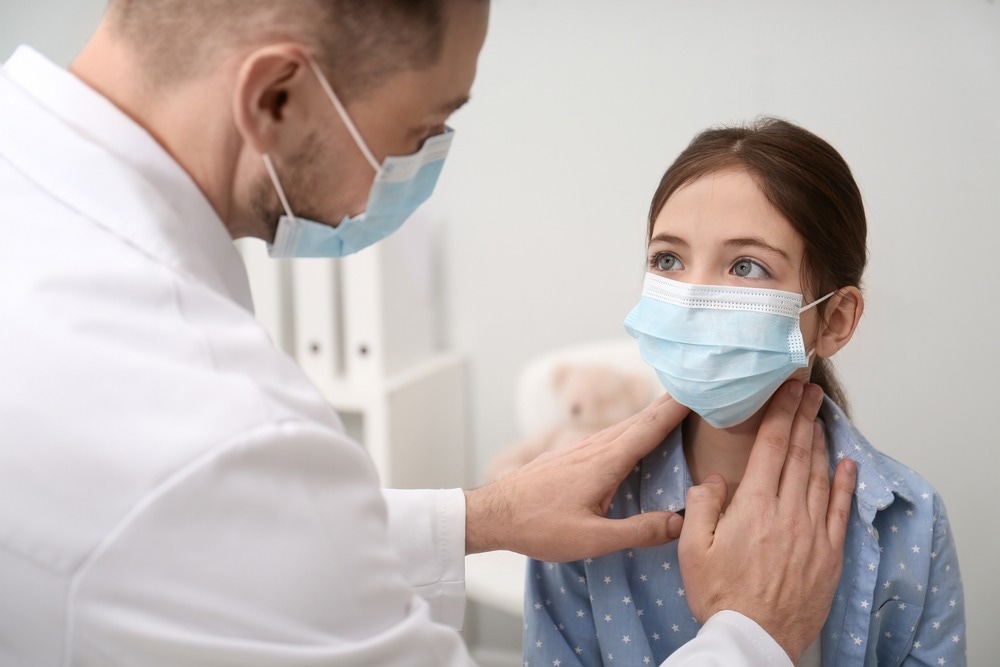With the coronavirus disease 2019 (COVID-19) pandemic, a lot of attention was focused on the healthcare systems of various countries, as they were put under a sudden and severe strain with the influx of hundreds of cases. Inevitably, this was associated with the relative neglect of other important conditions, including primary healthcare for children.
 Study: Service provision and utilisation in German paediatric primary care practices during public health crises: Protocol of the mixed-methods COVID-19 PedCare Study. Image Credit: New Africa/Shutterstock
Study: Service provision and utilisation in German paediatric primary care practices during public health crises: Protocol of the mixed-methods COVID-19 PedCare Study. Image Credit: New Africa/Shutterstock
A recent paper reported on the level of availability and use of pediatric primary health care services in Germany beginning with the onset of the pandemic. The researchers looked at how parents, adolescents, and primary care physicians viewed this phase, using a mixed-methods study design.
Introduction
It is a foregone conclusion that healthcare systems could not provide high-quality care for many clients during the pandemic, both because service providers and facilities were required for other purposes and because clients could not make use of the offered services under the public health restrictions in force, such as lockdowns and social distancing.
In pediatric healthcare, services for emergency care, special needs, including physiotherapy or occupational therapy, immunizations and elective surgeries, and cancer care are some areas severely compromised by the pandemic. This was reflected by higher rates of certain illnesses among children, most famously the increase in severe diabetic ketoacidosis among adolescents and children with type 1 diabetes.
Other chronic conditions may also have suffered from deferrals of care during this period, which will probably present as illness or death in the future.
The current protocol, published in BMJ Open, focuses on primary care pediatricians (PCPs) since they are the primary point of contact for 80% of children who need to access healthcare in many countries. They usually head up pediatric primary care practices.
They are responsible for acute care, as well as the management of chronic conditions, and the prevention of many illnesses. They also offer counseling and work in synchrony with community-based healthcare providers.
With this broad spectrum of activity, PCPs could step in during public health crises to minimize the disruption in healthcare for children. By providing "accessible and equitable services," they could tide over long periods of relative inaccessibility of higher pediatric facilities, provided they are allowed to continue functioning. This could, in turn, reduce unnecessary illnesses and deaths in this sector arising purely from restrictions or access barriers because of the public health crisis.
Earlier studies have reported that anywhere from 40% to 86% of pediatric primary care was cut off during the COVID-19 pandemic in terms of face-to-face consultations at such clinics. The reasons for this precipitous decline remain unknown but could include factors like the fear of infection, the need for COVID-19 testing before such a visit, the closure of clinics, or the absence of service providers.
In addition, lack of access to pediatric primary care is likely to disproportionately affect the weakest and most deprived children, increasing the impact of existing inequalities in health status. This has been shown to be so during past epidemics, as poorer and more remote households find it more difficult to access healthcare even as they remain at greater risk.
Thirdly, the need to physically change the set-up of consulting rooms to separate potentially infected patients from others meant a loss of time from actual care. This also involves organizational readiness for implementing change (ORIC), which includes both commitment and efficacy on the part of the organization in implementing change. This area needs to be studied to improve the ability of such pediatric primary care facilities to cope with future crises like the pandemic.
Study protocol
The current study, called the COVID-19 PedCare Study, aimed to look at the usage and availability of pediatric primary care by families during the pandemic and to identify barriers and positive factors. It also aimed at examining risk factors for poor pediatric care utilization at the socioeconomic level and the role of ORIC in providing such services.
The study will recruit parents and adolescents via the PCPs in the German state of Baden-Wuerttemberg. The consulting families for these PCPs will be able to participate in the study if willing. The PCPs taking part in the study will be recruited from Bavaria and Berlin, as well as all members of the German Society of Ambulatory Primary Care Paediatrics (Deutsche Gesellschaft für Ambulante Allgemeine Pädiatrie; DGAAP).
About 15 parents and 15 PCPs will be interviewed from diverse backgrounds. Adolescents will complete their survey on their parents' devices.
The prospects
The study is expected to help understand how public health crises impact pediatric primary care, with its comprehensive coverage of availability, utilization, and barriers/incentives to such care from three different perspectives. "We anticipate that this study will help to increase the resilience of paediatric primary care and thus limit excess morbidity and mortality."
The study's strengths lie in the authenticity of data gathered from the stakeholders. Further use of billing data from the pre-pandemic period could help extend the research in the future, comparing these perceptions with the objective reality.
Similarly, telephone interviews could help overcome the limitations of access to the surveys by families without literacy or internet access, especially targeting migrants and low-income families, and those in economic deprivation.
Finally, future studies should explore how to reduce healthcare access and utilization inequalities, using strategies like hiring community workers who speak an appropriate language or providing social support for vulnerable families.